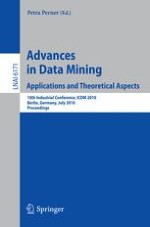These are the proceedings of the tenth event of the Industrial Conference on Data Mining ICDM held in Berlin (www.data-mining-forum.de). For this edition the Program Committee received 175 submissions. After the pe- review process, we accepted 49 high-quality papers for oral presentation that are included in this book. The topics range from theoretical aspects of data mining to app- cations of data mining such as on multimedia data, in marketing, finance and telec- munication, in medicine and agriculture, and in process control, industry and society. Extended versions of selected papers will appear in the international journal Trans- tions on Machine Learning and Data Mining (www.ibai-publishing.org/journal/mldm). Ten papers were selected for poster presentations and are published in the ICDM Poster Proceeding Volume by ibai-publishing (www.ibai-publishing.org). In conjunction with ICDM four workshops were held on special hot applicati- oriented topics in data mining: Data Mining in Marketing DMM, Data Mining in LifeScience DMLS, the Workshop on Case-Based Reasoning for Multimedia Data CBR-MD, and the Workshop on Data Mining in Agriculture DMA. The Workshop on Data Mining in Agriculture ran for the first time this year. All workshop papers will be published in the workshop proceedings by ibai-publishing (www.ibai-publishing.org). Selected papers of CBR-MD will be published in a special issue of the international journal Transactions on Case-Based Reasoning (www.ibai-publishing.org/journal/cbr).
